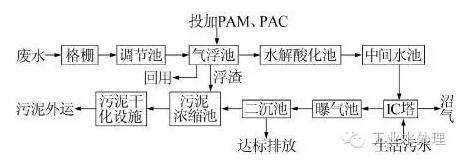With the increase of China's industrial structure adjustment and raw material exports, increasing demand for bobbin paper. Bobbin paper is a high strength board for textile industry manufacturing, chemical fiber and other roving bobbin paper core. Bobbin paper is a water and wastewater generated a great quantity of emerging industries. Crushing, washing, beating and dissociation of papermaking production technology of the wastewater mainly comes from raw materials. A lot of domestic research on recycled paper wastewater, but the engineering research for high concentration wastewater is seldom reported in bobbin paper.
Anhui a bobbin paper papermaking enterprises produced the bobbin paper wastewater COD of up to 12 000 mg / L, suspended solids 2 000-2 500 mg / L, and contains calcium salt, but the content of nitrogen and phosphorus is very low, biochemical performance is poor. Countries in the pulp and paper industry water pollutant discharge standard "(GB 3544 - 2008) in the plant tons of displacement made clear provisions, with lower emissions per ton of product, wastewater COD increased gradually, ordinary physicochemical treatment has long been unable to meet the discharge standard. How to efficiently handle the wastewater has generally been attached great importance to the environmental sector. According to Anhui, a bobbin paper papermaking enterprises have high concentrations of Bobbin Paper Wastewater by air flotation hydrolysis acidification - IC - aeration tank process, the organic pollutants degradation of wastewater were studied, bobbin paper wastewater treatment engineering to provide a certain reference.
1.1 Water quality of wastewater
Anhui a bobbin paper pulp and paper companies are set pulp, papermaking, wastewater treatment in one large bobbin paper production base. Enterprises with an annual output of bobbin paper products to 10 million T, stable production, daily discharge of wastewater from 1 000 m3, waste water and the sewage discharged into the city sewer water quality standards "(CJ 343 - 2010) as shown in Table 1 below.
Table 1 water quality and discharge standard of wastewater
| Project | pH | COD/(mg⋅L-1) | SS/(mg⋅L-1) | NH3-N/(mg⋅L-1) | TP/(mg⋅L-1) |
| Wastewater quality | 7.0~8.0 | 12 000~15 000 | 2000~2500 | - | - |
| Emission standard | 6.0~9.0 | 500 | 400 | 35 | 8 |
1.2 Technological process
Now according to the practical situation of the factory waste water, water using in flotation process based on series, anaerobic treatment facilities and combined with aerobic aeration tank process for wastewater treatment, the specific process as shown in Figure 1.

Figure 1 process flow
The sewage treatment system is composed of two parts, the pretreatment system and the biochemical treatment system. The production waste water is discharged from the waste water discharge pipe through the mechanical grid into the regulating pond, and through the pump to enter the air floatation tank. Air floatation tank using partial reflux pressurized dissolved air process, and in the pool with PAC and PAM, designed to remove SS and COD. 70% of the water used for gas to the production of paper, 30% of the gas to water pump sewage into the hydrolysis acidification pool. The hydrolysis acidification tank is provided with a nitrogen and phosphorus adding device to ensure the balance of the nutrients in the waste water. After mixing the waste water into the intermediate water tank, the water temperature of the steam can be adjusted to enter the IC tower for biochemical treatment. The biochemical performance of pretreated wastewater was good, and the treatment efficiency of IC tower was greatly improved. After settling into the aeration tank, the anaerobic effluent is discharged into the aeration tank, and the aerobic section is treated by the common activated sludge process, the aerobic effluent is discharged through the two settling tank.
Sludge treatment system mainly includes sludge thickening tank and sludge dewatering machine. Sludge sedimentation tank and air flotation scum collected into the sludge thickener, thickening, dewatering and drying after the mud cake Sinotrans landfill and comprehensive utilization.
(1) Air floatation tank. DAF in the back part of the pressurized dissolved air process, by adding PAC and PAM to remove water suspended solids and dissolved and colloidal substances, thereby reducing the effluent COD, SS and chroma, 70% of effluent for production, the rest of the wastewater discharged into the subsequent biochemical treatment system. 1, reinforced concrete structure, the diameter of 8 m, processing capacity of 150 m3/h.
(2) Hydrolysis acidification tank. In the pool to supplement the biological response to maintain the normal needs of nutrients, the proportion of investment in accordance with n (COD): n (N): n (P) =350: 5: 1. 1, reinforced concrete structure, size 14 m x 30m x 7 m, effective volume 2900 m3, maximum water depth of 6.5 HRT=54, h m, 4 units with a mixer at the same time.
(3)IC tower. IC tower through the reasonable structure design and its gas production to achieve the mixed liquid cycle, greatly enhance the slurry mixed contact and mass transfer effect, ensure the first reaction chamber high concentration sludge volume, and covers an area of small, anti shock loading ability strong, biological startup the advantages of faster, domestic wastewater treatment industry widely used. 2, carbon steel structure, internal and external corrosion, a single size of D 10 m x 23 HRT=72, H M.
(4) Aeration tank. After IC reactor treatment of wastewater into the aerobic treatment system, the author uses the common activated sludge process. 1, reinforced concrete structure, the monomer size of D 20 m x 5.5 HRT=34, h m, the use of blast aeration, with the wind machine 2 units.
(5)Two settling basin. 1, using radial flow sedimentation tank, reinforced concrete structure, the size of M 18 D x 4.5 m, equipped with peripheral drive scraping mud machine 1 sets. Sludge part of the return, the excess sludge from the sludge pump into the sludge thickening tank for processing.
(6)Sludge thickening tank. The residual sludge to store air flotation scum and biochemical system with periodic discharge of concentrated pool. Discharged after precipitation supernatant and concentrated sludge through the sludge conditioning tank conditioning is easy to dehydration of the sludge, the plate and frame filter press dewatering mud cake, Sinotrans to qualification units for subsequent processing. 1, reinforced concrete structure, size 5 m * 6 m * 6 m.
(7) Sludge dewatering machine room. 1 block, brick concrete structure, size 5 m * 6m * 3 m, sludge dewatering equipment selection plate and frame filter press, sludge generated after dehydration system, further reducing moisture content of sludge, mud cake formation, decrease the volume of sludge, and outsourcing.
3.1Sludge inoculation
(1) Hydrolysis acidification tank sludge. Sludge from municipal wastewater treatment plant sludge thickening tank sludge. In the early stage of inoculation, the sludge with water content of 99% t was added, and the MLSS was about 1000 mg/L in the pool at this time. Through mechanical agitation and the feeding of nutrients, so that the sludge in the most appropriate nutrition than the growth, the final MLSS to reach more than 5000 mg/L.
(2)IC anaerobic reactor sludge. Sludge from anaerobic digested sludge of a certain factory of Qingdao. Early to the IC tower investment and moisture content is 90% of dry sludge, sewage utilization life prepared water and control of COD is about 2 000 mg / L, ensure the water (COD) n: n (n): n (P) 350: 5: 1, while increasing the temperature inside the IC Tata until reached 37.5 degrees, measuring IC tower effluent COD. When the COD removal rate is stable at about 85%, you can gradually increase the influent load, increase the amount of 1000 mg/L each time, until the system reaches the design load, the anaerobic system debugging is over.
(3) Aerobic aeration tank sludge. Sludge from aerobic biochemical pool of city. Aerobic sludge with similar to the anaerobic sludge culture method and culture, adding fresh sludge sludge concentration of 500 mg / L, control system of dissolved oxygen in less than 2 mg / L, until they reach full load, biochemical system debugging end.
3.2 Operation result and analysis
The wastewater treatment project started construction in May 2012, the same year in October to enter the commissioning and operation, and in January 2013 the official operation. Project after 2 a stable operation, the effluent SS, COD monitoring



